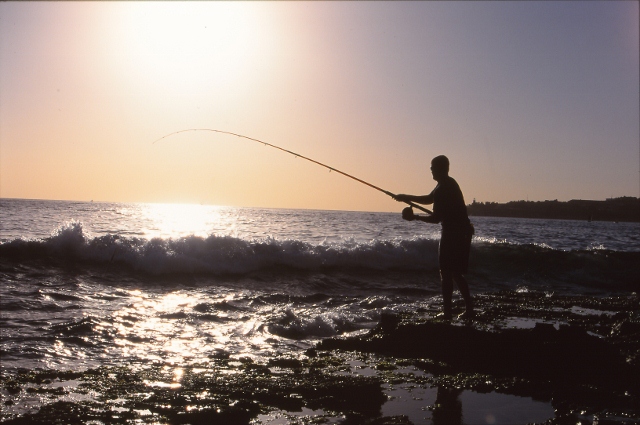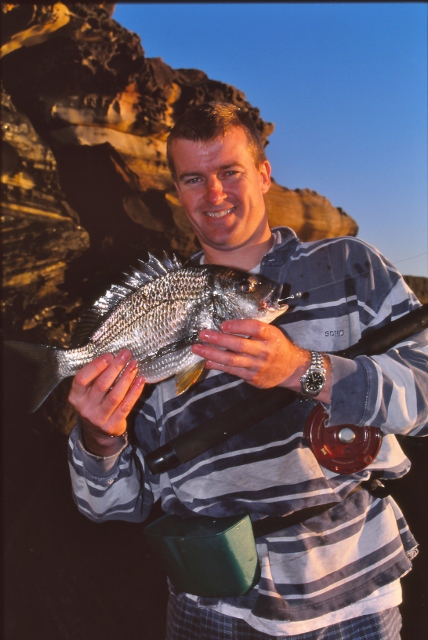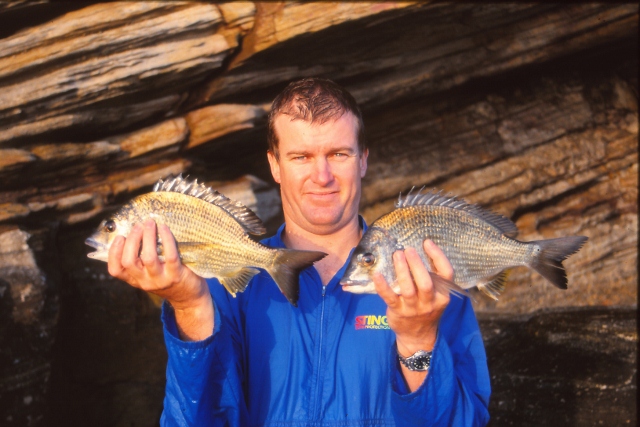{jcomments on}Every year around daylight savings I get the rock-fishing bug in a big way. The gear gets dragged out and checked, line replaced and hooks and sinkers replenished, all in anticipation of another great off-season. I say off-season because at this time of year the fishing reports become much less enthusiastic, the pelagic fish start to tail off, the flatties and whiting all but disappear, and it gets harder to get up for those early morning fishing trips. In truth it’s really just season two of the fishing calendar, a season where the smart fisherman targets different species and changes tactics.

If the meat and potatoes of the winter season are luderick and drummer, then the entrée and desert are the yellowfin bream. They frequent the Sydney rocks at about the same time each year, real honkers with blue noses and golden fins. The fish usually turn up late in April, peak in late May until June and taper off in July. The bream at this time of year are big, averaging just under a kilogram, hungry, and forage in shallow water, making them an exciting target.
BAIT
The key to catching these magnificent fish is simplicity itself, uncomplicated rigs, inexpensive quality tackle and fresh bread. Yes that’s right, bread, and fresh white bread to be precise. No need to be thawing blocks of lovely mullet gut, and no complaints from the lady about the mysterious packages in the freezer as a consequence.
Fresh bread is best for these fish for several reasons. When applied to the hook (with crust removed) and compressed tightly, your bread bait becomes heavy enough to cast a reasonable distance. Consequently you lessen the need for any additional weight. Most of the time I dispense with a sinker altogether, this allows the bread to wash around at mid water. If it’s a bit windy, or the sea is a bit rough, then a small pea sinker can be added as required. Another advantage of the mid water bait is that it tends to keep your offering free of ooglies, most notably the kelp fish which will make a meal of any nice prawn baits you put their way. Snags and lost tackle is also kept to a minimum with this approach because the bait is essentially snag-free and spends very little time bouncing along on rocks and kelp.

BERLEY
Use berley with caution, it can be a double-edged sword. I always have a few casts before using it, often finding that the bream are quite happy to play ball without it. When it is required, use “A little, often “, some of the best advice I have learnt over the years. Use just enough to get the fish interested and then to hold them in the desired spot. I tend to use just the crusts of the bread, letting them soak at my feet before the waves wash them back in. Over-berleying will usually just take the fish away from where you want them to be. This can happen even with judicious berleying if there is a stronger than normal current. I have had occasions where the fish were nowhere to be found, then, a “one last cast” 30 metres wide of the rocks was wolfed down by a kilo of silvery bream as it sank under the surface. This fish was rapidly followed by several more of the same size. Obviously the bream had been out wide sipping down my berley while I fed the kelpies. A valuable lesson learnt.

TACKLE
Tackle for this sort of fishing is both inexpensive and simple. A good quality rod of around 3.6 metres is ideal. I prefer a heavy ocean blackfish style rod for this type of fishing, that way I can use the one rod for bream, pigs and blackfish.
I also prefer to use two sidecast reels, one spooled with 4 kilo and the other with 8 kilo line. Threadlines could also be used, particularly if they are the kind that allows a fish to run with a bait. The 4 kilo is suitable for days when the seas are quiet, fish are timid and holding out wide in the shelter of a reef or bommie. The 8 kilo is better for when the sea is bumpy and the fish fearless and in close to boulders and shelves. The 8 kilo is your insurance for when the pigs turn up, usually when the sea is bumpy and gives you an even money chance of landing one.
Hooks should be sturdy and sharp. Chemically sharpened hooks are good if you stick to the inexpensive brands. I prefer forged hooks in a viking pattern for this type of fishing in sizes 1,1/0 and 2/0. Apart from the hook, the only terminal tackle required is the occasional pea sized ball sinker so it is good to have an assortment on hand.

LOCATIONS
So we have a heavy bait that we can cast, which will wash around at mid water, which is weed less and snag free, and, most importantly, which a bream will scoff down and run with. Now to place the bread bait where a bream is likely to be. I have found that the spots to look for are areas where shallow kelp covered reef adjoins deeper rocky reef, shallow water among boulders and white water between an outlying reef and the shore. All of these places are usually quite shallow, 3 metres at the most and as shallow as a metre. These formations allow the bream protection in the form of white water and rock formations to dart into, and a food source in form of crabs and shellfish that get dislodged by the wave action.

TIMES & TIDES
Tide is very important and forces you to move as it rises and falls. The ideal tide is one that is rising and if you can start fishing at mid tide on a rising tide at daylight or late afternoon, then you are on your way to some nice bream. Neap tides (small difference between high and low) allow you to get a longer crack at the good spots and keep the chance of strong currents to a minimum. Spring tides allow you to take advantage of the higher tides to access bait rich regions that the fish don’t usually get access to. This could mean cabbage or red weed beds or oyster-covered boulders. Fishing between the boulders on a spring tide before sunrise can yield some memorable captures. Casting to a shallow reef from half tide through the full tide during neaps offers much more consistent fishing.
TECHNIQUE
The technique used to cast to, hook and land bream with bread baits is very simple. The key to comfortable and safe fishing is good gear. A long rod matched with the appropriate sidecast or eggbeater will allow bread baits to be cast up to 30 metres but most casts are into shallow positions much closer into the rocks. Start by firing casts out deep enough so that the bait sinks back towards your intended position. Line maintenance is imperative at this stage and you need to retrieve and feed line as your bait moves around in the wash, try to keep the same amount of billow in your line at all times as this will help the bait to move naturally with the surge and the current. Small bites or pecks at the bait nearly always indicate that there are kelpies or some other undesirable about so don’t waste your time, reel in, check your bait and cast into another spot. Quality bream will nearly always pick up a bread bait in shallow water and run with it for several metres. You should be ready to let the bream peel line from the reel allowing as little resistance as possible before raising the rod tip firmly and smoothly to set the hook. Once hooked, use the length and softness of the rod to cushion the first run of the bream. At close quarters this can call for desperate rod work, thankfully the bream usually fight clean, and if you can steer them away from danger on that first run then they are easily landed. Remember to only take what fish you need. I stick to a personal bag limit of four bream but often keep only two if they are up around the 40 cm mark.
BYCATCH
Fishing with bread baits in the spots mentioned can yield some surprising catches. Most often the unintended hookup is on black drummer or pigs as they are known. With light bream gear the fight can be short and brutal. Quite often during the winter, sweep can get in on the act as well as trevally and even leatherjackets. The most surprising capture yet was a kilo plus tailor that hammered a bread bait on the retrieve, leaving my fishing buddy Jason a quivering wreck when he finally hauled it onto the rock platform.

Simplicity is the key to this rewarding way of prospecting for quality bream. When you add the size and condition of the fish available to the beauty of the spots where they are caught you arrive at a winning combination, one guaranteed to give anyone who likes a challenge a whole lifetime of fun.
